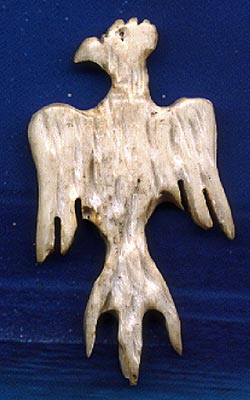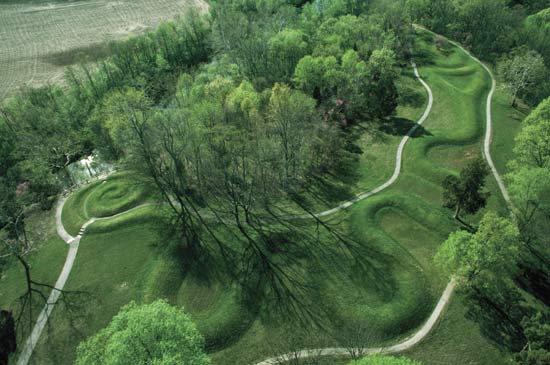Representing the relationship between the human and the spirit world ... the heavens and the celestial bodies.
Together he constitutes man's relationship between humans, animals and the spirit world.
A powerful shaman of the Ancient Ones
The Mound Builders were the leaders in the old civilizations ... there were no wars, no violence. They understood they were one with nature. They were a part of all the elements and life forms of nature and they revered life.

Building huge earthen structures (mud, rock, crystals etc.) they were very high and had a flat top. They were like a temple.
It was the place where Birdman lived and/or manifested.
He could be seen up there, many stories high on the flat platform, by the people who lived in the surrounding community here. He counseled with the Ancient Ones, the astute leaders …. and decisions were made for the good of the people. It was beneficial, loving and spiritual. The decisions were based on Advanced Wisdom from the Source

Carving from THE LITTLE PEOPLE
When their council sessions were complete, Birdman could be seen ascending, using his wings to fly into low-lying clouds.
The elder leaders of the people were aware that Birdman was in consultation with many more beings who were part of his advanced civilization beyond the clouds. At some point in history, the massive cloud that would appear above the temple began to thin, allowing people on the ground to see a huge structure standing stationary in the sky above the temple/mound. Soon it was common knowledge that the Shaman, Birdman, resided among his own people in the sky, over-seeing the Mound Builders on Earth.
The keepers of knowledge learned the advanced knowledge of Birdman, to become avid scholars and earthly stewards with human, animal and elemental species, with galactic forces, electro-magnetic fields and the cycles and powers of the sun, wind and water.
The people welcomed the family of Birdman, sight unseen, and everyone lived for the good of the tribes people, being equal and loved.
This was Creator-centered and in soul-contact with physical and non-physical beings. (Including the ancestors who had 'passed on' and yet remained to give wise counsel to the masses.)

Garuda the son of Kashyapa, the tsar of the birds, the rideable animal of Vishna
When Earth people died, their soul aspects remained available to confer with family members. The community leaders' souls remained in spirit within the temple to advise the new leaders. It was a spiritually-centered life.
According to the Wise Ones the spirits in the bones of the elders of the Ancient Ones, were interred within the layers of earth, renewed by cyclical fires, and re-construction of the Mounds, the homes, the Temples. The time of re-growth (the spring Equinox) was revered, as ancient wisdom streamed from all the plants, births, new councils, returning constellations, at that propitious time in Earth's cycle. The constellation containing Orion's belt was seen directly above them in the sky at this time. This was the place of origin of the Ancient Ones. People lived their lives in deep oneness and kinship with the Earth, the elements and the Sky people.
Upon entering the reception area of the great floating disk-shaped structure, he was met by his kinsmen on the ship. They were very tall Nordic beings, handsome of face and human-like. His form as Birdman changed. He let them see that he was one of the Starpeople and he was a Nordic as well. To work kindly and sensitively with the Mound Builders he appeared in a form they accepted as part of their mythology. He was part bird and part man. How appropriate! How inspiring for them.

The people loved the humanitarian Birdman and eventually, when the people were ready, the huge floating disk in the clouds was lowered into view, hovering above the flat roof of the temple, allowing the Mound Builder leaders and medicine people to enter. There they sat in counsel with the spiritual Birdman tribe and continued to pass on their wisdom to all the people who resided in those ancient of days.
Throughout most of the nineteenth century, it was believed that the tens of thousands of earthen mounds that dotted the central United States were engineering feats created by a mysterious, lost race - a race that had been destroyed by the less civilized Indians. Poet William Cullen Bryant, in 1832, expressed the sentiment of the period:
By the late 1880s, it was becoming clear that the mounds were actually built by ancestors of the numerous native American groups that still inhabited the central states, such as the Natchez. What was the history of ideas associated with the mounds and their builders, from the mid-nineteenth century explorations of curious citizens, to contemporary archaeological research in the Illinois River Valley.
It is now known that there were at least two major mound-building cultures: the Hopewell, which flourished between 300 B.C. and 300 A.D., and the Mississippian, which peaked around 1200 A.D. Hopewellian mounds are usually conical, earthen structures concealing burials in which marvelously carved stone pipes and mica cutouts are found along with skeletal remains.
The later Mississippian mounds tend to be square or rectangular, massive, flat-topped, mesa-like platforms on which houses or temples were erected. Archaeologists believe that a shift to settled maize agriculture had occurred by the time the Mississippian cultures appeared.
Such an economic base permitted the growth of veritable metropolises, such as Cahokia, near East St. Louis, where the largest mound stands 100 feet high and covers an area of almost 15 acres. At Cahokia, over 100 mounds formed the heart of a city-state that may have had a population of 20,000 and dominated an area about the size of New York State.
The red man came,
The roaming hunter tribes,
warlike and fierce,
And the mound builders vanished from the earth.
By the late 1880s, it was becoming clear that the mounds were actually built by ancestors of the numerous native American groups that still inhabited the central states, such as the Natchez. What was the history of ideas associated with the mounds and their builders, from the mid-nineteenth century explorations of curious citizens, to contemporary archaeological research in the Illinois River Valley.
It is now known that there were at least two major mound-building cultures: the Hopewell, which flourished between 300 B.C. and 300 A.D., and the Mississippian, which peaked around 1200 A.D. Hopewellian mounds are usually conical, earthen structures concealing burials in which marvelously carved stone pipes and mica cutouts are found along with skeletal remains.
The later Mississippian mounds tend to be square or rectangular, massive, flat-topped, mesa-like platforms on which houses or temples were erected. Archaeologists believe that a shift to settled maize agriculture had occurred by the time the Mississippian cultures appeared.
Such an economic base permitted the growth of veritable metropolises, such as Cahokia, near East St. Louis, where the largest mound stands 100 feet high and covers an area of almost 15 acres. At Cahokia, over 100 mounds formed the heart of a city-state that may have had a population of 20,000 and dominated an area about the size of New York State.


This comment has been removed by a blog administrator.
ReplyDelete